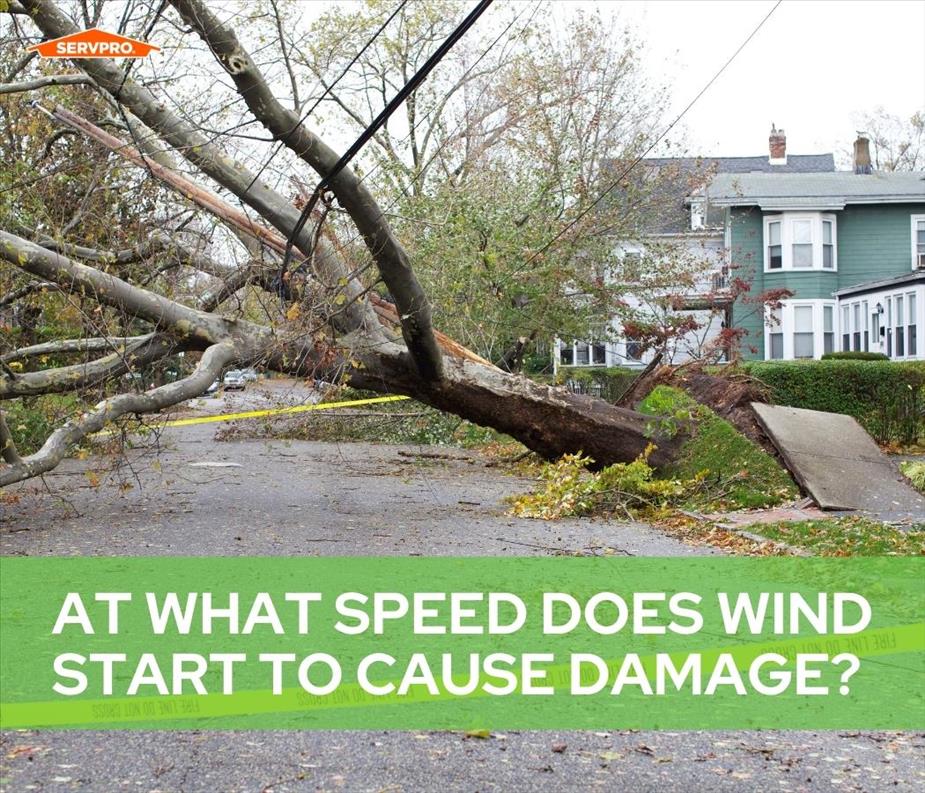At What Speed Does Wind Start to Cause Damage?
8/22/2022 (Permalink)
When you live in an area that experiences periodic windstorms, it is helpful to be aware of the potential risks of what these storms can do. While the inland Pacific Northwest is not subject to the hurricane-force winds that occasionally hit places like Florida, it has been known to have its share of high-wind storms that have knocked down trees, blown off roof tiles, and downed power lines, causing power outages for residents that have lasted weeks.
Residents in northern Idaho should know what can occur in severe wind events, and should take some steps to prepare, especially as fall arrives. Knowing the harms that can be caused by various wind speeds enables you to predict the likelihood of facing damage to your house or property. When you see a weather forecast or get a warning from the local utility companies that high winds are expected, take some steps to prepare your property, and know that SERVPRO of Coeur d’Alene is ready to step in and help if you need restoration work done.
Wind Speed and Associated Damage
0-25 mph: Winds in this range can feel pretty brisk, but rarely cause damage. If winds are a steady 10 mph, you can tell the kids to put a jacket on and get out their kites. But as they climb to the upper limits of this range, you can expect leaves to come off your trees, and you might want to take in your outdoor seat cushions or any other loose and light items off the porch or deck and stow them away so that you don’t have to hunt for them on the neighboring property when it’s all over.
25-50 mph: At this speed, it isn't unusual to lose a few shingles off the roof, especially when there are stronger gusts. Houses with aging roofs will, of course, be at greater risk for damage, and if you have a building that is not structurally sound, such as an old barn, you might see some destruction.
50-75 mph: At this speed, winds can be seriously damaging. Losing your roof shingles is common, and anything that is unsecured is likely to blow or tear off – including branches on dead or dying trees. If the ground has softened from rain, you can expect some trees to come down, especially if they have lots of branches and leaves or pine needles that will catch wind.
75-100 mph: With winds at this speed, even healthy trees can be uprooted. Mobile homes, trailers, and sheds can be destroyed, and even large moveable objects can become airborne, flying into cars and buildings.
Over 100mph: If you are facing winds like this, hopefully, you have evacuated the area. Even solid, newly-built homes will experience significant damage. This is category 2 hurricane-force wind, which can flip cars and blow out windows.
In the Coeur d’Alene-Spokane region, a wind storm that reaches 50 mph is not that uncommon in a storm season, and it can be accompanied by gusts that exceed 70 mph. To complicate matters, these storms may be accompanied by rain, snow, or ice, which can cause ice build-up on trees, roofs, and gutters, making them very heavy, and subject to collapse.
Protecting Your Home From Wind Damage
While there's nothing you can do to prevent bad weather, you can take proactive actions to help your home fare better in a storm by having a plan in place whenever a storm is a forecast. Here are some important items that should be part of your plan.
Declutter Your Yard: As the weather cools down, start putting away the items that you won’t be using, such as lounge cushions, decorations, lanterns, umbrella shades, shade sails, and so on. Even hoses and garden tools should be stowed for the season so that you don’t have to worry about them getting damaged from rain and ice. Take down the wasp traps, and hanging plants. Any easily moveable object is subject to get either blown away or may become a projectile if winds pick it up. Furniture, too, should be secured or stowed, so it doesn’t get knocked over and damaged.
Maintain Your Home: Check your roof to see if it needs repairs, and check other items on your roof: skylights, vents, chimneys. If they need repairs, do them before the storm season hits, or you may be looking at doing more extensive repairs later–and doing them in cold, unpleasant weather. Check your windows, outdoor light fixtures, and door seals.
Check the Area Around Your House: Take a good look at the area around your home and property. Are any trees liable to hit your house if they fall down? Are there heavy, low branches that should be pruned? Are any of the trees dead or dying? Are the power lines and power poles clear? A few prudent steps now can save you from disaster.
Storm Restoration Companies Should be Available 24/7
Sometimes, even when you prepare well, you can still suffer from a natural disaster. If you suffer any storm damage, know that our team at SERVPRO is ready to help. We serve our community around the clock and arrive faster to any disaster, no matter what time of day. When disaster hits, put our number on speed-dial to contact SERVPRO and receive the professional help you need.



 24/7 Emergency Service
24/7 Emergency Service
